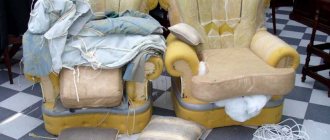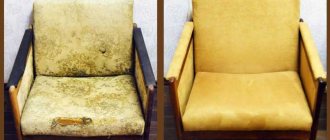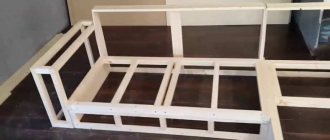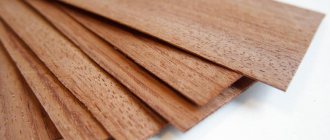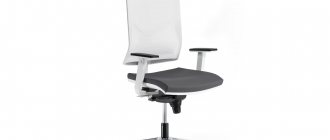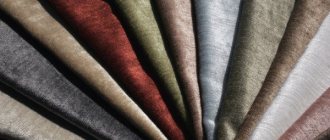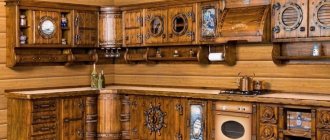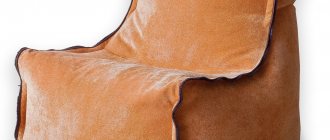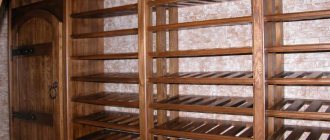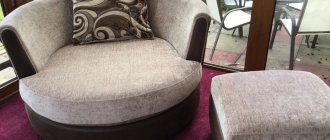How to choose fabric?
When choosing fabric for furniture, it is necessary to take into account factors such as wear resistance and strength. Today, fabrics are presented in a diverse range.
- If the chair will be in the living room, you can choose jacquard; this fabric has a printed pattern and retains its good appearance for a long time.
- A children's room is a place that should be not only cozy, but also practical. It is best to choose a fabric like flock; it is easy to clean and very practical to use. Flock is also chosen if there are animals in the house, this saves the furniture from the claws of a pet.
- Chenille is very resistant to various odors, it is great for the kitchen and balcony if people smoke on it.
In addition, you can opt for velor, leatherette, matting, suede and similar fabrics.
Retro style in the interior 2022
Soviet furniture can become a noticeable element of interiors of the following styles:
- Scandinavian;
- retro;
- classical;
- minimalism;
- Provence;
- loft.
In the photo you can see how organically antique pieces of furniture fit into this design. The classic retro style is characterized by:
- rich colors;
- wallpaper with primitive designs;
- rough plaster;
- floor with geometric pattern;
- bright high-pile carpets;
- furniture of unusual shape.
For such an interior in the style of the 50s-70s, lacquered furniture made of wood and shiny plastic is suitable. In the living room, for example, you can put a sofa on short steel legs, upholstered in rough red, olive, and blue fabric. Bookshelves are attached to the walls, which are covered with glass, and a wooden coffee table with a lacquer lid is placed in the center. A floor lamp with a fabric lampshade, a polished sideboard, a bookcase right up to the ceiling, and round chairs made of thick plastic will fit into this retro design. You can put a record player and colored glass vases in the sideboard. Checkerboard tiles, parquet or brown laminate are laid on the floor. If you couldn’t find real Soviet furniture, you can buy stylized ones. There are entire designer collections that include many retro-style interior items.
A large wooden buffet is suitable for a Provence kitchen. It can be painted olive, turquoise, lilac or beige, and the doors can be painted. It is advisable to place vintage soft wooden chairs from the USSR era around the table. But if they are dark brown, then they need to be decorated “to resemble Provence.”
A light lacquered desk and a soft wooden chair will fit into a Scandi office. And for a Scandinavian living room, a Soviet sofa with soft armrests is suitable. If you put bright sofa cushions on it, it will look stylish and completely different.
The loft is characterized by wooden furniture with a shiny laminated surface
But it is important that the layer of varnish does not hide the texture of the wood, but that the natural pattern is clearly visible. In a minimalist apartment there is also a place for Soviet wooden furniture
A dark lacquered chest of drawers can be placed in the hallway, and bedside tables with round gold or silver handles can be placed in the bedroom or living room.
Re-upholstery tools
- Hammer, screwdriver, pliers
- Stapler and scissors
- Wide sling
- Fabric (required size)
- Filling – it can be synthetic winterizer or foam rubber
- Glue, gauze
A sewing machine is used to sew covers, but first you need to take accurate measurements of the back and seat of the chair, as well as the armrests, if any.
Receipt
Potassium chloride is obtained from sylvinite (a conglomerate of sylvinite KCl and halite NaCl) in two ways:
- The halurgical method is based on the different solubilities of sodium and potassium chlorides at appropriate temperatures. The solubility of potassium chloride doubles when the temperature increases from 20 to 100°C, but the solubility of sodium chloride does not change.
- Flotation method. The separation of sylvinite and halite is based on the different ability of the surface of particles of these minerals to be wetted by water. Flotation potassium chloride has larger natural pink crystals. Hydrophobic additives (fatty amines) used in the flotation process significantly reduce the hygroscopicity and caking properties of the fertilizer.
GOST 4568-95 Potassium chloride. Technical conditions. Official publication. Interstate Council for Standardization, Metrology and Certification, Minsk.IPK. Standards Publishing House, 1996. 15 p.
Korenkov D.A. Fertilizers, their properties and methods of use / Edited by D.A. Korenkov. – M.: Kolos, 1982. – 415 p.
Mineev V.G. Agrochemistry: Textbook. – 2nd edition, revised and expanded. – M.: Moscow State University Publishing House, KolosS Publishing House, 2004. – 720 p., l. ill.: ill. – (Classical university textbook).
https://www.youtube.com/watch?v=ytcreatorsru
Muravin E.A. Agrochemistry. – M. KolosS, 2003. – 384 p.: ill. – (Textbooks and teaching aids for students of secondary educational institutions).
Chemical Encyclopedia: in 5 volumes: Volume 2: Daffa - Copper / Editorial Board: Knunyants I.L. (chief editor) and others - M.: Soviet Encyclopedia, 1990. - 671 pp.: ill.
https://www.youtube.com/watch?v=ytpolicyandsafetyru
Yagodin B.A., Zhukov Yu.P., Kobzarenko V.I. Agrochemistry / Edited by B.A. Yagodina. – M.: Kolos, 2002. – 584 pp.: ill (Textbooks and teaching aids for students of higher educational institutions).
How to disassemble the chair?
If you don’t know how to reupholster a chair with your own hands, first of all, you need to disassemble the furniture and find out what condition the filling and wooden frame are in. We evaluate the appearance of the chair, determining what needs to be replaced.
The tenon parts must be carefully knocked out with a rubber hammer. The grooves must be cleaned, glued with glue, a bandage wrapped on top and, after complete drying, hammered into place.
After this, the foam rubber is replaced. Its dimensions should correspond to the dimensions of the old foam rubber. If necessary, the passes are replaced; they can be rubber or canvas; a stapler is used to attach new passes.
Restoration of frame parts
The concept of “restoration” includes not only reupholstery, but also restoration of the wooden parts of the chair. Over time, decorative parts (armrests, turned elements, curly chair legs) become unusable, that is, they become dull, the varnish surface wears off, and small cracks appear on the furniture frame.
What can be done in this case?
To solve this problem we will need:
- Sandpaper,
- Scraper,
- Blade from a stationery knife.
- Varnish, stain.
Every part needs to be sanded. You need to start with coarse grains, gradually moving to smaller ones.
Sanding should only be done in the direction of the grain. If you make movements against the grain, the varnish will definitely show transverse lines.
Many master restorers use a drill with special sanding drums to remove old varnish. They come in different widths and lengths and are very convenient for sanding hard-to-reach places.
- After the parts have been sanded, carefully remove the dust with a damp cloth or foam sponge.
- Apply nitro varnish with a soft brush until completely dry.
- After the varnish has dried, you can run your hand over the surface and feel how the pile rises. Using the finest sandpaper, we carefully “knock down” the raised fibers, that is, we make the surface smooth.
- Then you can apply a stain (alcohol, water or white spirit based) and only then cover it with any commercially available varnish.
Chair upholstery with fabric
The back must be cut from the first meter of fabric, and the seat from what remains. Try on a piece of fabric to the chair so as not to make mistakes in the measurements.
The cover is attached to the frame with a stapler; if you cannot sew the covers yourself, it is best to contact a sewing workshop. The tension should be done in your direction, when the cover is nailed to the frame, the distance between the staples or nails should be no more than four centimeters.
When doing work, you need to be careful. It is worth remembering that it is important to have properly sewn covers of suitable sizes, and then the reupholstery will certainly work out.
Attach the seat to the chair
Depending on what fasteners you originally used, use them to secure the seat to the base of the chair. I attached the seat with a glue gun, since my chair is used more for decorative purposes - it stands in a corner, I put a blanket, clothes on it, and put a bag on it. If you plan to use the chair to its fullest extent, then it is better to take care of a more serious fastening.
This is what happened in the end!
There was an old, shabby chair that I felt sorry for and wanted to throw in the trash, but what came out was a bright and cheerful yellow chair with a modern print on the fabric that fits perfectly into the interior. Paint and a brush can work wonders.
Car seat reupholstery
Reupholstering car seats is also a complex job that requires attention and patience. If you want to do this at home, then you need to familiarize yourself with the technology.
To begin with, a fabric is selected; the following fabrics are most often used for car interiors:
- — Suede and leather;
- — Alcantara;
- — Flock;
- — Velor;
You can choose the color of the fabric to match the color of the interior, but you can also use your imagination and make the upholstery in any color you wish. Before reupholstering, car seats must be removed. After this, all pieces of old covers are measured; the total area of new covers should be twenty to forty percent larger.
In order to avoid making mistakes and do the job well, it is best to watch a video of reupholstering a chair with your own hands, which provides detailed instructions. A new interior with fresh covers will delight the owner and all passengers in the cabin for a long time.
Paint a chair
An important question is what paint to paint the chair. It’s very simple: I came to the store and asked the consultant to advise what paint would be suitable for painting a wooden chair. They recommended semi-matte Tikurilla Pesto 30 to me. I chose the color from palettes in the store and the consultant mixed me the right jar of paint.
I painted the chair three times in total. When you apply paint for the first time, you want to exclaim “Whoa?” The paint is applied in a thin layer, the dark wood shines through it, and the brush leaves grooves in the paint. The main thing here is patience.
Between each coat I waited a day for the paint to dry completely.
Office chair reupholstery
Office chairs are very comfortable and durable. But even they require updating over time. That is why reupholstering such chairs is an opportunity to update furniture and give it a second life.
Artificial leather and thin fabrics can be used as materials for upholstery. If necessary, the frame, base, and filler are replaced.
Of the necessary tools you need to prepare the following set:
- — Stapler;
- - Scissors;
- — Screwdriver;
- - And also the fabric itself.
Before reupholstering, the chair must be disassembled. When measuring fabric for covers, you must not forget about the allowances; they should be enough for the covering. The remaining allowances after work must be carefully trimmed with scissors.
When disassembling the frame, do not lose the screws, as they will be needed for reassembly, and the absence of some of them will delay this process.
Application
Industry
Potassium chloride is used as a component for the production of complex mineral fertilizers. Granulated potassium chloride – for the production of mixed mineral fertilizers containing three main plant nutrients.
Potassium chloride is used in metallurgy, pyrotechnics, photography, as well as in textile, glass, soap, pharmaceutical, pulp and paper, leather and many other industries.
For the production of leather substitutes, synthetic rubbers, feed and baker's yeast, “fine” potassium chloride is used.
For the production of therapeutic and prophylactic salts, potassium chloride is used, not treated with anti-caking agents.
Useful tips
If you are determined to reupholster the furniture yourself, you need to know special tricks that will help you avoid ruining your favorite chair. There are contraindications to self-stretching, these include:
- The furniture has a complex geometric shape.
- Furniture should be upholstered with natural fabric or very expensive material.
- The furniture is expensive or antique.
In this case, it is better not to take risks and trust the professionals. Correctly reupholstering an office chair has fewer subtleties, but this is also not a simple matter. The main thing is to follow the instructions and have at least the slightest idea of how to disassemble and assemble furniture.
When choosing upholstery, do not forget to take into account the overall interior of the room, the chair should fit into it, and the fabric itself should match the room. The old upholstery must be removed very carefully, as it will serve as a convenient template for creating new covers. The pattern on the fabric must match on all parts of the upholstery.
If you have never reupholstered furniture, try to start with the simplest thing - it could be a stool, ottoman or an old chair that is not particularly valuable. Thanks to these tips, renovating old, worn-out furniture will be successful and will be an enjoyable and exciting experience for you.
Behavior in soil
Potassium chloride is used on all types of soils in accordance with the recommendations for potash fertilizers.
Potassium chloride, like all potash fertilizers, is highly soluble in water. When introduced into the soil, it dissolves in the soil solution, and then interacts with the soil absorption complex according to the type of exchange (physicochemical), and partially non-exchange absorption. The mechanism of potassium behavior in the soil is common to all potassium fertilizers.
The chlorine contained in this fertilizer may have a negative effect on some plants. Therefore, fertilizers are placed in a more moist layer of soil, from which chlorine is washed out by autumn-spring precipitation and does not have a negative effect on chlorophobic crops.
Photo of DIY chair reupholstery
Types of array
The main property of solid wood is that it consists entirely of wood and does not have any synthetic impurities. Naturally, this characteristic affects the quality of the product. Furniture items made from solid wood are highly durable, and also add a touch of elegance and high aesthetics to even the simplest interior.
The durability of such chairs is associated with the characteristics of the wood structure and its chemical properties.
Due to the fact that solid wood retains sufficient elasticity when maintaining a certain temperature, during the manufacturing process the product can be given absolutely any shape. In addition, furniture made using this technique retains good thermal conductivity for a long time, which is an important quality for armchairs.
Solid wood products (especially handmade ones) are versatile and can fit into any design project. All thanks to unique natural patterns. Now the furniture market is overflowing with cheaper options of the so-called “laminated solid wood”. But it is not difficult to distinguish such a product from a high-quality solid wood chair - the latter have patterns on the surface with a gradual color transition. It happens that when creating a more economical version of a chair, designers use two types of array.
Impact on crops
Potassium chloride, while having a general positive effect on many plants, can have a negative effect on chlorophobic crops.
– chlorophobic crops that react negatively to excess chlorine in the soil (it leads to a decrease in yield). At the same time, they are very potassium-loving. The negative impact of the chlorine component is eliminated by adjusting the doses, timing and methods of adding calcium chloride.
– potassium-loving crops, less sensitive to chlorine. In England, in addition to potassium fertilizers, sodium chloride is also applied to sugar and fodder beets.
less demanding on potassium fertilizers.
Physical and chemical characteristics
Potassium chloride (pure substance) - colorless crystals with a cubic lattice. At a temperature of 298°C and a pressure of 1.95 MPa, a cubic modification is formed.
- Solubility in water (g per 100 g): at 0°C – 28.1,
- at 20°C – 34.3,
- at 40°C – 40.3,
- at 100°C 56.2.
Potassium chloride is produced by industry in two forms: granular (first and second grade) and fine (first and second grade).
https://www.youtube.com/watch?v=CljFli5z9DM{amp}amp;t=936s
Granular - compressed irregularly shaped granules of grayish-white or various shades of red-brown color, or large crystals of grayish-white color.
Fine - small crystals of grayish-white color or small grains of various shades of red-brown color.
- The mass fraction of potassium in terms of K2O for both brands: for the first grade - 60%, for the second - 58%.
- Mass fraction of water: in granular – 0.5%, in fine – 1%.
- Friability – 100%.
What will you need for work?
A certain set of materials and tools for restoration, of course, is needed. If you already have paint brushes, paints and standard tools, you need to buy much less than if you start restoration from scratch. What you need to update your furniture:
- spatula and chisel;
- screwdriver;
- hammer;
- wood glue;
- stationery knife;
- roller;
- a set of brushes;
- varnish with moisture-resistant properties;
- acrylic paints;
- foam;
- grinding machine;
- sandpaper;
- stapler;
- new springs;
- awl;
- screwdriver;
- large needles with silk threads.
Everything else is optional. Fabric for covering, decoupage for decorating armrests, rivets can be included in the design project. But the list outlined above is what will be useful in virtually every case. With these tools, you can successfully restore the chair.
Preparation
Immediately before restoration work, the products should be prepared.
To begin, disassemble the product into individual elements: remove the drawers, remove the doors, glass, unscrew the fittings and fasteners. There is no need to separate the glued elements!
Next, you need to get rid of the old layer of varnish or paint. You can do this in the following ways:
- using a hair dryer;
- sandpaper;
- special solvent removers;
- grinding machine.
Removing old coating with sandpaper
For greater efficiency, you can combine several options. When working, be sure to use personal protective equipment: masks, respirators, gloves
If there is any damage on the wooden surface (chips, deep scratches, cracks, etc.), they need to be repaired. For this we use special means. It is advisable to select the color to match the tone of the wood from which the item is made. If, after filling defects, you need to imitate the structure of wood, use the following materials:
- wax – ideal for filling scratches and small cracks. First you need to melt it on the stove or using a burner;
- sealant - can be used for the same damage as wax;
- putty - it is convenient to fill large, deep chips and damage.
Be sure to remove excess materials. After drying, go over the coating with fine-grained sandpaper - this will help level the surface, eliminate transitions between the restored areas and the rest of the area, and remove roughness. Wipe surfaces thoroughly with a soft, damp cloth and dry. Further actions will depend on the chosen restoration method.
Tip: at the very beginning of the work, we recommend taking a “before” photo - this way you will not only capture the appearance of the object before the transformation, but you will also be able to later see how all the elements are attached.
Assembly
To assemble a computer chair after the reupholstery procedure, it is important to assemble all the parts in the same order as they were taken apart. Having prepared the updated elements, the seat, and, if necessary, the backrest, you must immediately attach the base to which all other elements will be screwed
On the seat, armrests and a metal structure for the back are attached to the base. If the backrest was reupholstered, then after putting on the base, it must be inserted into a metal corner and clamped with a bolt with a large plastic head.
Before you sit down on a chair and try out the fruits of your work, you should go through all the fasteners and check their reliability in order to prevent deformation or loosening of any parts. Once the full check is completed, you can safely sit on the chair and enjoy the new, beautiful and comfortable furniture.
Furniture disassembly
In order to disassemble the chair, you will need the following tools:
- pliers;
- keys;
- Phillips and regular screwdrivers;
- pliers.
First of all, you need to remove the back wall and plywood bottom of the chair. They are usually secured with small nails or screws. If the plywood is suitable for further use, then it should be removed carefully.
Remove the foam padding that is located underneath the seat and gives the chair its elasticity. Tighten the nuts securing the legs to the back of the furniture. If the fasteners are rusty, use a special liquid to remove corrosion from the metal.
Next, you need to remove the old upholstery and remove the softening layer from the backrest. To do this, use a flat-head screwdriver and pliers. Use a screwdriver to pry up the old brackets so that one of the fastening legs comes out of the wooden surface. The staple is then finally removed with pliers.
By prying several fasteners at once, you will avoid damaging the plywood. Remove them sequentially to avoid getting scratched by staples that have not yet been removed. A skin wound caused by rusty metal can cause a lot of trouble. Therefore, it is best to disassemble the chair while wearing gloves or mittens.
After removing all fasteners, the old upholstery is removed and the gasket is removed. Old foam rubber can crumble and fall apart into pieces. If you are restoring furniture in an apartment, then lay plastic film or newspapers on the floor. And only then remove the worn-out chair softening, otherwise small debris will scatter throughout the room.
The wooden frame of the chair is restored separately. It is necessary to remove a layer of varnish or paint from it, glue the loose elements and paint all parts of the structure.
